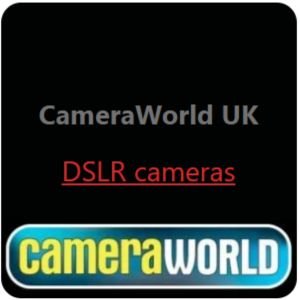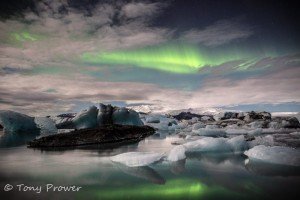New Moon
This is a night photo, from Jokulsarlon glacier lagoon in Iceland, captured a comet disappearing into the North sky over Iceland. This was the comet which promised to swing quite close to Earth, but this was as close as it got. Not sure what caused all that green blurring? Maybe it is comet gas? Or green Goblin Fire.
Purchase as a print in the Galleries.
This was new moon time at Jökulsarlon which is great for Northern lights photography. The lack of light pollution can allow you to see and photograph dimmer aurora displays. It also lets you see the other colours than GREEN. If you look at Northern Lights photos taken with a full moon, they will all have nothing but GREEN northern lights. Getting great colours requires shooting in complete darkness. For that you may need a professional level sensor in your camera.
Magic Cloth Photography
Magic Cloth Photography is a fantastic method to capture a high dynamic range scene. It is a perfect graduated filter for Night Photography.
When you like to balance the highlights in the sky with the shadows on the ground like a regular Northern lights photography, the Magic Cloth Photography is a free tool for your camera bag and flexible for your needs.
Camera Accessories
No Filters: It is important to shoot your Aurora scenes without filters. Dark filters will work against you if you are trying to avoid noticeable star trails. Circular filters such as Polarizer Filters will create concentric lines in your photo. The concentric lines are not awful, but they are noticeable and difficult to get rid of.
Strong Tripod
If you are taking such a long exposure with stars – it’s important to have a perfectly still camera. Having a strong, heavy tripod is the easiest way to solve this challenge.
Sometimes a tripod has a hook , suspend something from it to give better strength. Many travel photographers carry a special tripod harness to place rocks and stones to give a better stability which will support the tripod well. This would also be fine for other types of long exposure photography. This tripod accessory is also called a ‘Stone Bag’.
Remote Release
Most DSLRs will allow up to a 30 second exposure. Exposure times can sometimes be longer than the 30 sec. These cameras will also have a BULB mode ‘B’ on the control dial or after the timed exposures. Having a Remote release (sometimes called “Remote) will allow you to open the shutter: as long as your battery will allow.
Black Cloth
A black cloth is useful for both the ‘Black Hat’ and ‘Magic Cloth’ technique. Pick a big cloth like a mouse-mat, or black card of similar size. Must be large enough to totally cover the lens. Better to be Black. A dark colour is preferable. You can normally make a straight edge out of any cloth. If it is cold, then a glove or mitten will suffice because it is such a long exposure, but try to aim for a straight edge on your glove. I achieve this by pulling on the little finger.
Exposure Time
When you have established the correct exposure for the Northern Lights (say 20 seconds), you can then multiply that time by 3 to allow extra exposure on the landscape. It is important not to allow any further exposure on the sky, once you have covered up. This can lead to undesirable star ghosts. For this reason it is important to know your composition and where the horizon is. Bare your lens while the sky exposes (approx. 20 seconds), then cover the whole lens and carefully raise the cloth so as not to expose any more sky. Continue with a slow up and down motion in the foreground area. Use a slight angle to work the bottom corners to give them the most exposure.
“To me, photography is an art of observation. It’s about finding something interesting in an ordinary place… I’ve found it has little to do with the things you see and everything to do with the way you see them.”
— Elliott Erwitt

















